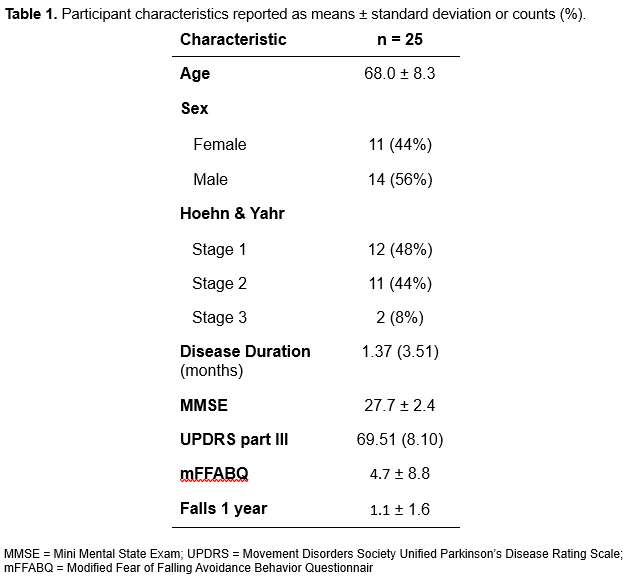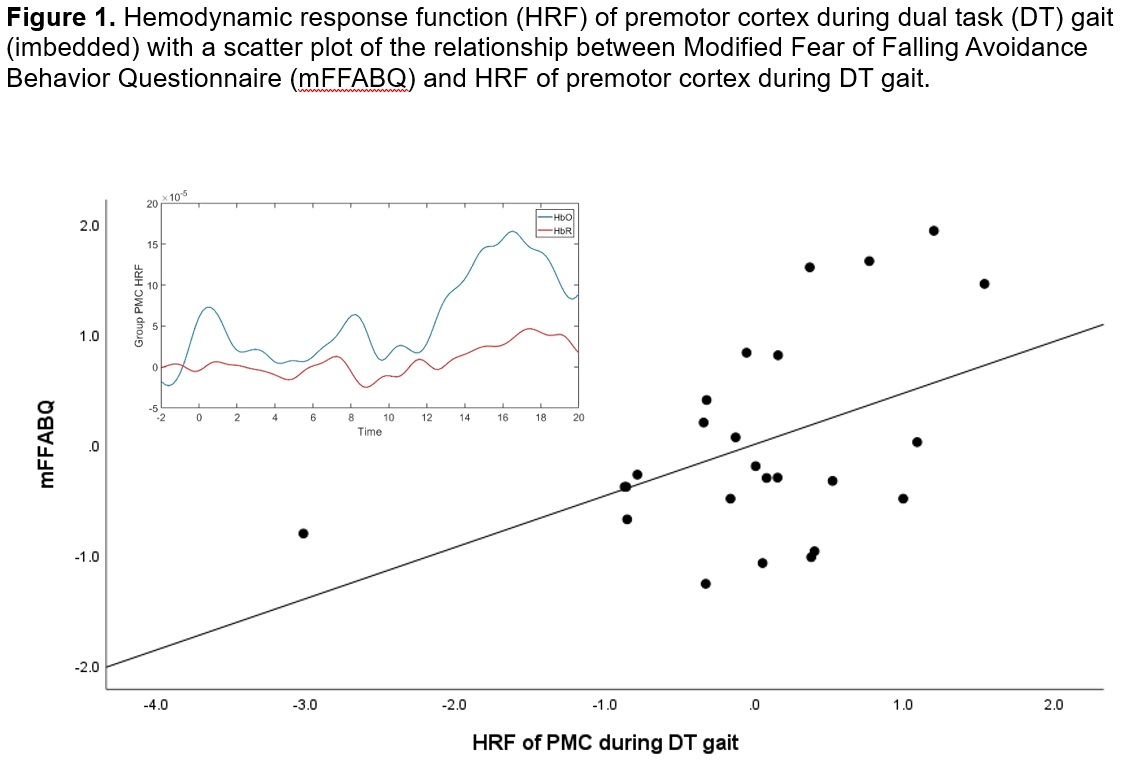Objective: The purpose of this study was to determine the relationship between fear of falling avoidance behavior (FFAB) and cortical hemodynamic response during dual-task (DT) gait among individuals with Parkinson’s disease (PD).
Background: People with PD often experience FFAB which contributes to a vicious cycle that leads to deconditioning and furthering of postural instability. However, little is understood about the underlying neural mechanisms that are related to FFAB.
Method: Data were collected from 25 individuals diagnosed with PD, including demographics (age, sex), disease severity (Hoehn and Yahr, Movement disorders Unified PD rating scale (MDS-UPDRS), disease duration), and FFAB (modified FFAB questionnaire (mFFABQ)) (see table 1). Additionally, cortical hemodynamics were measured during DT gait using a 42 channel fNIRS system. The DT consisted of ambulating at the participants’ preferred pace while simultaneously counting to 20. fNIRs data was processed in MATLab using HOMER3 and consisted of removal of physiologic and motion artifact (utilizing accelerometer and short separation channel data) and conversion from intensity to concentration. The mean hemodynamic response function was then calculated and averaged regionally across channels.
Results: The hemodynamic response of premotor cortex (PMC) during DT gait was correlated with FFAB (ρ=0.608, p=0.001). Subsequently a hierarchical linear regression analysis was conducted. In block 1 age and sex were not related to mFFABQ (p=0.116). In block 2, the hemodynamic response of the PMC was entered and improved the model fit (b=0.465, p=0.026), accounting for 17.7% of the variance in FFAB (see Figure 1). The final model explained 35.5% of the variance in FFAB (F(3,21)=3.85, p=0.024).
Conclusion: More FFAB was related to greater hemodynamic responses in the PMC during DT gait. The PMC’s role in externally mediated attention and motor planning may contribute to this finding. It may be that individuals with elevated FFAB rely on the PMC to attend to and plan the execution of complex tasks. Taken together, these results support the proposal that interventions that reduce PMC activation, such as entraining DT motor performance to become more automatic, may contribute to the interruption of the vicious cycle of FFAB in PD.
Table 1
Figure 1
To cite this abstract in AMA style:
C. Papantonatos, S. Carlson, YF. Chiu, N. Fritz, D. Peterson, J. Longhurst. The neural contributions to fear of falling avoidance behavior in Parkinson’s disease: preliminary evidence from a mobile neuroimaging paradigm [abstract]. Mov Disord. 2024; 39 (suppl 1). https://www.mdsabstracts.org/abstract/the-neural-contributions-to-fear-of-falling-avoidance-behavior-in-parkinsons-disease-preliminary-evidence-from-a-mobile-neuroimaging-paradigm/. Accessed December 28, 2025.« Back to 2024 International Congress
MDS Abstracts - https://www.mdsabstracts.org/abstract/the-neural-contributions-to-fear-of-falling-avoidance-behavior-in-parkinsons-disease-preliminary-evidence-from-a-mobile-neuroimaging-paradigm/


